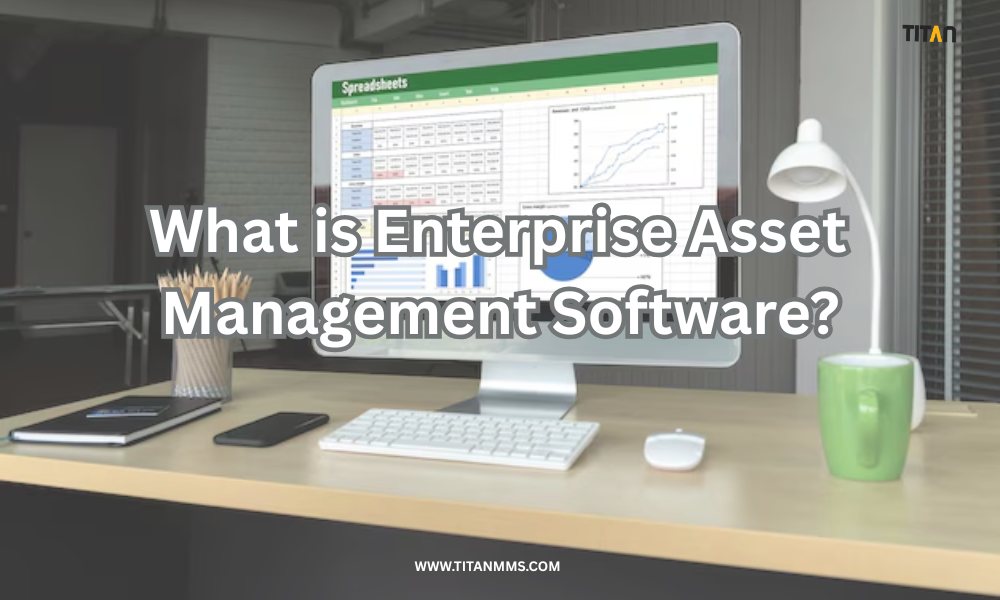Enterprise Asset Management (EAM) is no longer just about tracking assets about maximizing efficiency, reducing costs, and ensuring long-term growth. With the rise of modern enterprise asset management software, businesses can streamline operations, improve decision-making, and extend the lifecycle of their physical assets. In this guide, we’ll explore the meaning of enterprise asset management, its importance, key features, and the best enterprise asset management software available in 2025.
Learn How to Improve Work Order Management.

What is Enterprise Asset Management Software? (Definition + Meaning)
Enterprise Asset Management (EAM) refers to the process of tracking, maintaining, and optimizing assets across their entire lifecycle from procurement to disposal. These assets may include equipment, vehicles, buildings, IT infrastructure, or machinery.
- Enterprise Asset Management Meaning: Managing all physical assets systematically to improve efficiency.
- Enterprise Asset Management Definition: A combination of processes, people, and technology to maximize asset performance.
- Poor Enterprise Asset Management: When organizations fail to track and maintain their assets properly, it leads to higher costs, downtime, and increased asset failures.
In today’s fast-moving industries, enterprise asset management systems are essential for efficiency, compliance, and cost control.
Learn Web-Based & Cloud-Based asset management.
Why Do Businesses Need Enterprise Asset Management Software?
Enterprise asset management software (EAM software) helps organizations:
- Track and monitor assets in real-time
- Schedule preventive maintenance and reduce downtime
- Improve vendor and purchase order management
- Ensure regulatory compliance
- Generate reports and actionable insights
- Integrate with mobile tools for on-the-go access
Simply put, the best EAM software allows companies to transform asset-heavy operations into data-driven, efficient systems.
Key Features of Enterprise Asset Management Systems
A modern enterprise asset management system usually includes:
- Asset Tracking & Lifecycle Management – Monitor performance from purchase to disposal.
- Inventory & Vendor Management – Maintain stock levels and manage suppliers effectively.
- Mobile Enterprise Asset Management – Access data and perform updates from smartphones or tablets.
- Work Order & Maintenance Scheduling – Plan preventive maintenance to avoid costly breakdowns.
- Analytics & Reporting – Real-time insights for smarter business decisions.
- CRM & Integration Modules – Connect with ERP, finance, and other enterprise systems.
Importance of Choosing the Best Enterprise Asset Management Software
The best enterprise asset management solutions help reduce operational costs, minimize downtime, and increase productivity. Businesses can automate maintenance tasks, gain real-time visibility into assets, and ensure regulatory compliance.
Some of the critical features include:
- Asset tracking and performance analysis
- Maintenance scheduling and work order management
- Inventory and procurement integration
- Reporting and analytics
- Integration with ERP and IoT systems
Why Poor Enterprise Asset Management Can Hurt Business
Poor enterprise asset management results in excess maintenance costs, increased equipment downtime, and reduced asset lifespan constraints. It impacts downtime and creates risks to safety, compliance concerns, and inefficiency in the use of natural resources. Over time, it has the potential to damage brand reputation and lead to catastrophic financial losses.
Enterprise Asset Management Meaning in 2025
The enterprise asset management meaning has evolved beyond simple asset tracking. In 2025, it refers to a strategic, digital-first approach that integrates AI, IoT, and cloud technologies to maximize the performance and value of physical assets.
Modern EAM platforms enable organizations to:
- Predict failures using real-time data and AI
- Automate preventive maintenance schedules
- Optimize lifecycle costing and budgeting
- Integrate with mobile devices for field operations
- Ensure ESG (Environmental, Social, Governance) compliance
Enterprise Asset Management Industry Trends
The Enterprise Asset Management (EAM) industry is undergoing rapid digital transformation, with market projections indicating significant growth. According to MarketsandMarkets (2023), the global EAM market is expected to reach $7.8 billion by 2027, expanding at a 13.2% CAGR. Similarly, Grand View Research (2023) forecasts a $10.4 billion valuation by 2030, driven by IoT and predictive analytics adoption. Fortune Business Insights (2024) further predicts the market will surpass $9.5 billion by 2029, emphasizing cloud-based EAM solutions, while Gartner highlights AI integration as a key accelerator for this growth.
Key trends include:
- AI-powered asset intelligence
- Cloud-based solutions for real-time data access
- Mobile-friendly platforms for on-the-go asset control
- Sustainability integration to meet green compliance
- Cybersecurity features to protect critical infrastructure
Enterprise Asset Management Best Practices
To get the most out of your EAM system:
- Automate maintenance scheduling.
- Use mobile tools for real-time updates.
- Integrate with ERP and finance systems.
- Train employees effectively.
- Analyze asset data for predictive maintenance.
These practices transform asset management from a reactive task into a proactive strategy.
Common Challenges in EAM (and How to Avoid Poor Asset Management)
Organizations often face issues with:
- Unplanned downtime
- Lack of real-time data
- Manual record-keeping
- High maintenance costs
The solution lies in enterprise asset management best practices, automation, mobile integration, predictive maintenance, and vendor collaboration.
Top Features to Look for in the Best Enterprise Asset Management Solutions
When selecting the best enterprise asset management software, ensure it includes:
- Real-time asset tracking
- Predictive maintenance capabilities
- Mobile access and app integration
- Customizable dashboards and reports
- Scalability for future growth
- Robust security controls
Mobile Enterprise Asset Management: The Future of EAM
With remote teams and 24/7 operations, mobile enterprise asset management is becoming a necessity. Mobile-first EAM systems enable:
- Remote monitoring of assets
- Real-time maintenance updates
- Faster decision-making from anywhere
- Better workforce efficiency
Businesses that adopt mobile EAM are better positioned to handle challenges like equipment downtime and asset mismanagement.
Enterprise Digital Asset Management Solutions
While EAM has for a long time focused mainly on the physical assets of a business, enterprise digital asset management solutions are growing in importance and influence, managing digital files – documents, images, videos, and software assets – where the solutions will ensure searchability of digital resources and ensure they are secure and accessible to the Organization.
Use cases include:
- Managing brand assets
- Controlling software licenses
- Enforcing version control
- Streamlining creative workflows
Enterprise Asset Management Software Comparison
Before making a purchase, conduct a thorough enterprise asset management software comparison. Evaluate key factors like:
| Feature | Importance | Notes |
|---|---|---|
| Deployment Type (Cloud/On-Prem) | High | Choose based on your IT ecosystem |
| User Interface | High | Easy-to-use UI improves adoption |
| Integration Capabilities | High | Sync with ERP, CRM, CMMS, etc. |
| AI & Predictive Tools | Medium to High | Ideal for long-term ROI |
| Mobile Functionality | High | Necessary for remote teams |
| Vendor Support & Training | High | Critical during setup and scaling |
| Pricing & Licensing | Medium | Ensure transparent pricing |
Best Enterprise Asset Management Software in 2025
Here’s a curated list of the best enterprise asset management solutions platforms for 2025:
- IBM Maximo – Comprehensive, AI-driven EAM system.
- Infor EAM (Hexagon EAM) – Cloud-based, highly scalable.
- SAP EAM – Enterprise-grade with strong integration features.
- Eptura Asset Management – Simplified, mobile-first approach.
- TitanMMS EAM – Flexible, easy-to-use, and tailored for growing enterprises.
When choosing the best EAM software, look for scalability, integration, mobile access, and advanced analytics.
Benefits of Implementing Enterprise Asset Management
When organizations invest in enterprise asset management software, they gain:
- Improved Asset Lifespan
- Lower Operational Costs
- Better Compliance & Risk Management
- Real-Time Performance Monitoring
- Streamlined Maintenance Schedules
Conclusion
Enterprise Asset Management (EAM) software is now a must-have for asset-intensive industries from manufacturing and healthcare to utilities, logistics, and beyond. By adopting the best enterprise asset management solutions, organizations can improve efficiency, reduce downtime, and maximize ROI. Understanding the enterprise asset management definition, following best practices, and avoiding poor asset management decisions empowers businesses to make data-driven choices that enhance performance and profitability. Modern EAM software goes beyond basic tracking, integrating mobile access, cloud platforms, and AI-powered insights to deliver smarter, faster results. Whether you’re evaluating mobile enterprise asset management or searching for the best EAM software, the future of asset management lies in intelligent, integrated, and scalable systems built to drive long-term success.
Learn How to Train Your Team for Effective CMMS Use.
Frequently Asked Questions
It’s a system that helps organizations track, maintain, and optimize physical assets throughout their lifecycle, improving efficiency and reducing costs.
EAM manages asset lifecycles.
CMMS focuses on maintenance tasks.
ERP handles broader business functions like finance and HR.
Look for asset tracking, predictive maintenance, mobile access, analytics, integration with ERP, and cloud-based deployment.
It leads to downtime, high repair costs, safety issues, and lost productivity—all of which hurt business performance.
Set clear goals, centralize data, automate maintenance, train users, and monitor system performance regularly.
